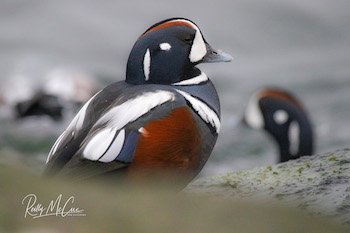Harlequin Duck

Harlequin Duck (Histrionicus histrionics) is a unique, beautifully marked sea duck that makes its living on rocky marine shorelines, moving to inland white water streams to breed. Looking somewhat like an abstract master artist painted it, the harlequin duck is defined primarily by its deeply dark denim-blue plumage, chestnut flanks and thick white brushstroke highlights forming white circle behind the eyes, a crescent behind the bill, a thin slit further back on the head, a thick collar, and a diagonally positioned patch pointing towards the chest. The head is a deep navy blue and the rest of the body is a dark sooty blue, old penny-colored chestnut sides. Hen harlequin ducks lack the color contrast; are muted soot color with a distinctive white patch behind the head similarly to drakes. Harlequin duck vocalizations have been described as “sea mouse.” More squeaks than quack variations.
Available Hunts

In North America, Harlequin Ducks are comprised of 2 distinct breeding populations, the Atlantic and Pacific. During the breeding season, the Atlantic population can be found in Quebec, Labrador, Newfoundland, and New Brunswick. The more abundant Pacific population inhabits most of Alaska, Yukon, and western Northwest Territories.
Harlequin Duck habitat preferences include fast-flowing streams and rivers, rocky coastlines, cobble beaches, and exposed areas with boulders onto which they’ll perch. The feed on small crustaceans. They move inland to nest, building their nests on cliff sides but have also been known to use tree cavities or nest on the ground. The Atlantic wintering population migrates to western Greenland. The Pacific population winters in the Aleutian Islands, down the coast of British Columbia, continuing to the coast of California.
In the United States, harlequin duck may not be hunted in the Atlantic Flyway. They are proliferate throughout coastal Alaska, where the bag limits are 4 daily. Further south, in Washington’s Puget Sound, the limit is 1 annually. No more wary than most sea duck species, they’ll decoy readily to a few harlequin decoys and blind requirements are no more complicated than motionless hunters on the nearby rocky shoreline.







